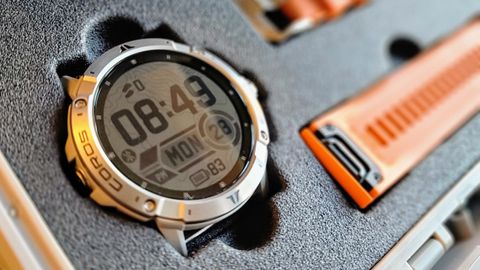Tom's Guide Verdict
This ginormous GPS sports watch offers customized fitness tracking, ultra-rugged construction, and super-stellar battery life
Pros
- +
Waterproof construction
- +
Good battery life
- +
Swappable wristbands
- +
Customizable watch faces
- +
Compatible with Strava (and other 3rd party apps)
Cons
- -
Premium price tag
- -
Bulky, clunky on the wrist
- -
Can be uncomfortable over long periods
- -
Manual HRV readings instead of auto
- -
Proprietary charging cable
- -
No solar options
Why you can trust Tom's Guide
The Coros Vertix 2 is half smartwatch, half GPS sports watch, and all business from the moment you slap it on your wrist. Whether you’re an ultra runner, mountain climber, cross-country skier, or all-around fitness fanatic, this weatherproof wearable is like a digital Swiss Army knife for the great outdoors — no matter where the dusty trails may take you.
We’ve been testing the Coros Vertix 2 over the past few months, and put it through its paces on a number of different training sessions — from a trail marathon to home gym strength training. But how does the Coros Vertix 2 compare to other GPS sports watches we’ve tested, such as the Garmin Fenix 7? Read my full Vertix 2 review to see if it belongs on your sweaty, sweaty radar.
Coros Vertix 2 review: Price and availability
The Coros Vertix 2 costs an eyebrow-raising $699 from the company’s website. There are two primary silicone band colors to choose from: Obsidian and Lava. You can purchase additional nylon or silicone bands for $29 each. I immediately appreciated the heavy duty packaging the Vertix 2 came in.
Display size: 1.4 inches
Screen resolution: 280 x 280 (64 colors)
Watch size: 50.3 x 50.3 x 15.7 millimeters
Weight: 89 grams (with silicone band), 72 grams (with nylon band)
Water resistance: 10ATM (100 meters / 328 feet)
Working temperature: -22°F to 122°F (-30°C to 50°C)
Battery life: 240 hours (UltraMax GPS), 140 hours (Standard Full GPS), 90 hours (all systems on), 50 hours (all systems + dual frequency on), 60 days (daily use)
Satellite systems: GPS, GLONASS, Galileo, Beidou, QZSS
Connectivity: Wi-Fi, Bluetooth
Third-party integration: Komoot, TrainingPeaks, Strava, Relive, adidas Running, Apple Health, Stryd, Final Surge, Runalyze, Running Quotient, Decathlon
Onboard storage: 32GB
Offline music: Yes
Band material: Silicone / nylon
Starting at $699 and topping off at $999 for the Sapphire Solar Edition, the new Garmin Fenix 7 is no doubt a competitor here. Whereas the Fenix 7 comes in three different diameter options (42mm, 47mm, and 51mm) and multiple “editions” to suit different budgets, fitness needs and wrist sizes, there’s only one model of the Vertix 2, which has a case diameter of 50.3mm — up from 47mm with the original Vertix. There are no solar editions of the Coros Vertix 2.
Coros sells a $79 carabiner accessory to clip the watch onto a belt (or backpack) instead of wearing it on your arm. Coros also carries a $25 keychain watch charger for when you’re really off the grid for a while, and the $69 Coros POD (Performance Optimization Device) for advanced running metrics. One thing’s for sure: Coros’ target audience isn’t your average couch potato.
Coros Vertix 2 review: Design, display, and sensors
You can still pick up the original Coros Vertix for $499, but the newer Vertix 2 is marginally improved in a variety of ways. For one, the 1.4-inch LCD touchscreen (up from 1.2 inches) has a slightly higher resolution of 280 x 280 (versus 240 x 240), and with the larger screen diameter comes some noticeable heft: 50.3 x 50.3 millimeters (89 grams with the silicone band) in comparison to the prior model’s 47 x 47-millimeter footprint and weight of 76 grams.
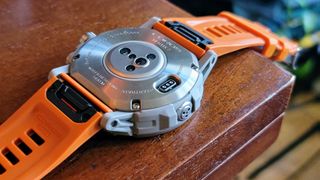
Similar to the Fenix 7, the Vertix 2 has a scratch-resistant screen and bezel. It’s the bulkiest watch I’ve ever worn for any length of time, and since my band was bright orange, it became an instant fashion accessory — whether I liked it or not.
Speaking of fashion-forward fitness, I counted 90 different watch faces within the Coros smartphone app, and you can store five of them on the watch itself at any given time. (I fancy myself a trail runner, so I settled on one called Topography.)
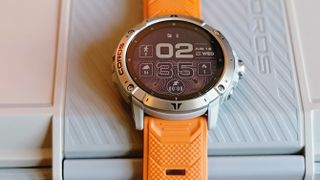
In order for the rear sensors to work correctly (and negate any forearm flexion), Coros recommends leaving a 1cm gap between your wrist bone and the watch itself; the higher the watch is worn above the wrist bone — flush with the surface of your skin without being loose — the better. The trick is to find the tightest setting that won’t cut off any circulation, which takes a little trial-and-error.
The Coros Vertix 2 is waterproof to 100 meters (328 feet) — down from 150 meters (492 feet) with the original Vertix — but if it’s any consolation, the newer model has a higher threshold for lower working temperatures: -22°F to 122°F (-30°C to 50°C) versus -4°F to 140°F (-20°C to 60°C). This is great news for any alpine climbers, ski instructors, snowboarders, and mountain guides.
One key difference between the original Vertix and Vertix 2 has to do with global connectivity. Whereas the former connects to GPS and QZSS alone, the latter also syncs up to GLONASS, Galileo, and Beidou satellites at the same time — in dual frequency if desired — while still offering phenomenal battery life along the way. (More on that below.) Plus, the Vertix 2 boasts 20% faster performance over the original Vertix. While it’s hard to quantify this extra boost in anecdotal scenarios, zipping from one menu to the next throughout my testing was hiccup-free, and it never took more than ten seconds for the satellites to get a lock on my position whenever I started tracking an outdoor activity. (Even amid the tall buildings of midtown Manhattan.)
Though I didn’t get the chance to test this feature, Coros also offers global offline mapping. You can download your topographical map by region via Coros.com, and then access it directly from the watch, even when GPS coverage is spotty.
The Vertix 2 is equipped with a wide range of sensors, including the usual 3D compass, gyroscope, accelerometer, and barometric altimeter you’ll find on typical GPS sports watches. Like other competitors in this space, the Vertix 2 also has an optical heart rate monitor, thermometer, optical pulse oximeter, and electrocardiogram sensor.
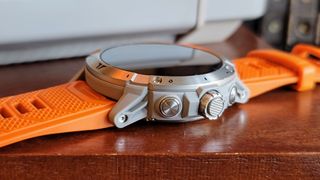
On the back of the watch, you’ll find a port for Coros’ proprietary charger, which is a little disappointing; I would have preferred a USB-C connection of some kind, but what can ya do?
The main controls for the Vertix 2 are refreshingly minimalist. There are two buttons and a larger dial on one side of the watch, which can be calibrated to be worn on either wrist:
Light – The light button doubles as a long-press shortcut for a number of go-to functions, such as the HRV test, stopwatch, GPS maps, night mode, and more.
Digital Dial – The Vertix 2 has a digital dial that works in tandem with contextualized touchscreen controls. It also works as a sensor to unlock the screen, and a one-stop shop for all the main workout tracking features.
Back / Lap – Use this button to navigate backward when scrolling through the vast selection of menus; a long press from the home screen takes you to the main toolbox/shortcut menu.
Coros Vertix 2 review: Running and sports features
To put this watch through its proverbial paces, I wore it every day for roughly three months in tandem with the training I’d already started for my first trail marathon. I carved out roughly 14 weeks of prep time for this particular project, and received the Vertix 2 right in the middle of week five.
A good fitness wearable should be able to track your heart rate, sleep patterns, stress levels, and essentially any athletic activity on your shortlist. The Vertix 2 has fitness tracking covered in spades thanks to the aforementioned optical heart rate monitor, thermometer, optical pulse oximeter, electrocardiogram sensor, and an Altitude mode that regularly evaluates blood oxygen Sp02 levels (and your overall fitness) at altitudes above 2,500 meters, which is nifty for avid climbers and alpinists.
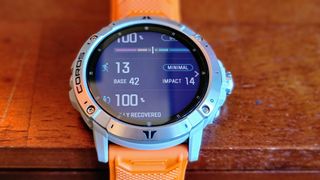
The Vertix 2 automatically tracks your active energy (both daily and active calories), exercise time, heart rate, and sleep habits, but you have to take daily HRV readings manually, which isn’t ideal.
Today’s fitness tech tends to get subjectively smarter the longer you use it, and the Coros platform is no different. Enter the EvoLab, a platform that calculates your weekly training load to keep you at the top of your game. Once EvoLab had collected seven full workouts worth of data, it helped keep me honest as I attempted to push higher and higher cardio thresholds without putting myself at the risk of potential injury. It was pretty motivational to see all my personal records in one place, too.
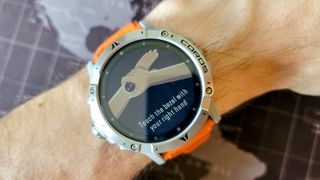
Thanks to the Vertix 2’s integration with a variety of third-party fitness apps (eg, Apple Health, TrainingPeaks, WeRun and more), my workout was uploaded directly to Strava whenever I finished tracking a workout.
Proper sleeping habits are absolutely essential for any regular running routine — especially when it comes to longer distances — and the Vertix 2 illustrated how mine fell short on the data side of things. Once I knew what to tweak, my sleeping patterns gradually improved over time, and I could map my progress as I went. I must admit, the watch isn’t the comfiest to sleep in, however.

I did most of my testing for this watch on the run, but there are currently 27 different activities you can track from the Vertix 2. In my case, I put in roughly 200 miles worth of trail and treadmill running throughout my testing process; the more data the Vertix 2 collected, the more useful it became for tweaking my daily routines, workouts, and sleeping habits.
Ahead of my race, I was able to download the GPX file directly to my phone, into the Coros app, and then onto the watch itself. This allowed me to study the full topography of the entire course route ahead of time. You can also convert any of your recorded runs into a route, should it strike your fancy, with alerts to let you know if you veer off-course. This is helpful for traversing particularly technical terrain, but panning around the map in real time takes some getting used to.
Coros Vertix 2 review: Smartwatch features
As a smartwatch, the Vertix 2 comes with a few other nifty features baked in:
Insta360 camera remote – If you own an Insta360 One X2 or One R camera, you can control it right from the watch. This is a new feature for the Vertix 2.
Offline music – You can store up to 32GB of data on the Vertix 2, which is great for when you want to unplug…but not too much. You have to sideload MP3 files for now, but the technology is there to support future streaming services, especially since the Vertix 2 is already compatible with some of the best running headphones.
Storm alerts – Lets you know when the weather’s about to get gnarly. Nice.
In the middle of my testing, the Vertix 2 went through two major software and firmware updates: one in March, and another in May. The end result? A mindful overhaul of the whole Coros ecosystem, including an optimized outdoor run tracking experience; Find My Phone and Find My Watch support; improved sleep detection (including REM stage); and more.
Coros Vertix 2 review: Battery Life
The Coros Vertix 2 is rated for 140 hours and 60 days of normal use over standard GPS (ie, connected only to GPS and QZSS), and 90 hours with all systems on (ie, simultaneously connected to GPS, GLONASS, Galileo, Beidou, and QZSS). Switch over to UltraMax GPS mode, however, and Coros says you can eke up to 240 hours out of the Vertix 2, which is impressive to say the least.
By way of comparison, the Garmin Fenix 7 (Standard Edition) is rated for up to 57 days of use in battery saver mode, and up to 136 hours in Max Battery GPS mode. Garmin adds solar power to their long list of features, however, which gives this tried-and-true GPS brand an edge for outdoor activity tracking.
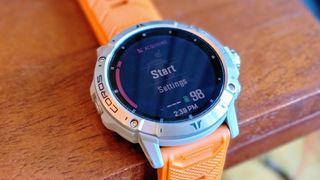
Indeed, it took a full month of daily use over standard GPS for the Vertix 2’s battery to drop from 100% to 19%, though I wasn’t exactly maxing out the watch’s GPS capabilities during most of my testing, which primarily occurred within the five boroughs of New York City — where most of our existence is at sea level.
Coros Vertix 2 review: Verdict
The longer I used this GPS sports watch, the less I had to critique. From the perspective of a casual hybrid athlete, the overall feature set is objectively impressive.
That being said, if you want a fitness wearable that’s as discreet as the Whoop 4.0, the Vertix 2 probably isn’t the droid you’re looking for. But if you can embrace the extra bulk — not to mention the hefty price of entry — this beautiful bad boy is on par with some of the best Garmin watches available today, hands-down.
If your pockets aren’t quite deep enough for the Vertix 2, you may want to consider the Garmin Forerunner 255, or the Garmin Forerunner 55, which both have more than enough tech on board to get you round your first, or fastest, marathon.

As a freelance journalist, TJ has over a decade of multi-medium storytelling under his belt. Leveraging a quarter century of collective coddiwompling amid the ever-evolving landscape of wireless gadgetry, his unique editorial background allows him to explore a variety of tech-centric subsectors on this fascinating planet. When he's not field testing new gear in the Catskills, Adirondacks, or an actual field, he can be found sipping Negronis in his living room and crafting Dr. Seussian poetry inside a tattered moleskin.
